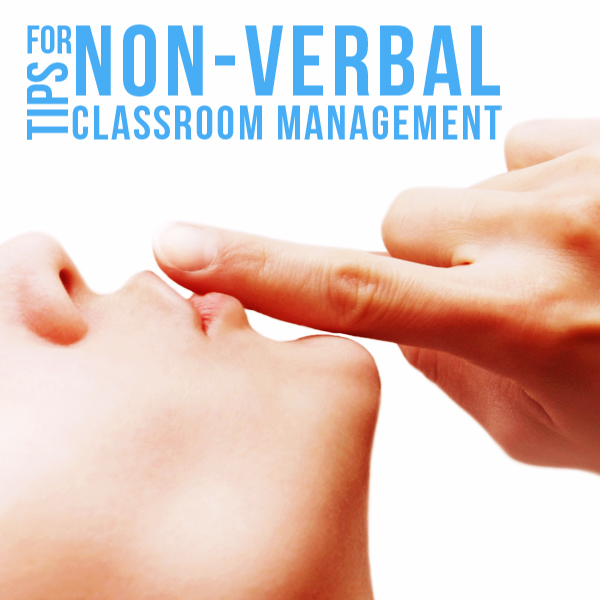This is the second post in the new series I’m introducing on The Cornerstone called Real Teachers, Real Tips. Each month, I’ll invite one educator to share a few classroom management tips that have worked in his or her classroom. I’m hoping to feature a wide cross-section of teachers from all different parts of the world, at all different grade levels, in all different teaching scenarios. Want to be featured here? Just fill out the guest blog form!
August’s featured teacher is Tammi Pittaro, a super talented educator who’s been in the field for 35 years!! Thank you, Tammi, for sharing your perspective here.
Hello! My name is Tammi from presentlygifted.org. I am a fairly new blogger and mostly write about teaching students with high academic potential. I am excited and honored to be here as the guest blogger! Angela has asked me to share a post about non-verbal classroom management. She believes, as I do, that managing a classroom successfully is the backbone of good teaching. But first, just a little about me…

I live and teach in southeastern New Jersey, not far from the bright lights of Atlantic City and the Pine Barrens forest. I have taught in the same school district for the past 35 years. About half of this time has been at the elementary level as a classroom teacher, and the other half as a gifted and talented/enrichment specialist in grades K through 8. Currently, I teach and coordinate our district’s pullout gifted and talented program. I teach over 100 identified students in small groups in three schools during the course of the week, as well as working with whole classrooms of kindergarten students. My program is project-based and concentrates on developing creativity, critical thinking skills, problem solving and how to do authentic research. A good dose of classroom technology is thrown into the mix as well. I love, love, love to teach and work with kids of all ages, and after 35 years, teaching continues to make me smile everyday!
As I am gearing up for a new school year, I am thinking about the basics. In my opinion, classroom management is the glue that holds everything together. A strong classroom management system has always been important to me, but as a teacher who works with various groups of children each day, I have come to truly realize that it is the key to successful teaching. Since the time I have with my students is limited, it is important that we make the most of every moment. Classroom focus needs to be on learning instead of discipline. There is just too much curriculum to teach and too little time for interruptions due to student behaviors such as talking, daydreaming, distracting others and fooling around. I talk all day long as it is, so I don’t want to use my voice any more than I need to! Nonverbal classroom management techniques can really help to make the classroom a more productive and happy place for everyone.

What does nonverbal classroom management look like and how can a teacher keep students focused on learning without using words or sounds? Here are five very simple, no-cost, low-tech ways that have worked for me over the years.
1. One, Two, Three…Eyes on Me!
I have found that making eye contact with each child early and often in the day or the period helps him or her stay on track in the classroom. I make sure I greet each student warmly by name and look him or her in the eye upon entering my classroom. Then, during direct teaching or working with a few students, I make sure I continue to do so. Students are more likely to stay on task and behave appropriately when they know the teacher is watching. Making eye contact, especially in Western cultures, signifies respect, interest, appreciation, trust and friendship. It’s an important skill to teach young children and to model as you teach.
2. Work the room
Where you stand or teach can make a big difference. Moving around as you teach helps keep your students focused. Without skipping a beat, you can move nearer to those students who might be distracted or fooling around. Your proximity will send a message to get back to business, and you don’t usually have to say a word. Pause for a few moments near the student who has been off-task and teach from there for a bit before moving on. A little eye contact helps here as well. A good practice while students are working independently or in small groups is to keep moving among them. I’ve observed (and experienced first hand) that when teachers sit, trouble can be brewing at the opposite end of the classroom! And most of us can use the extra physical activity!
3. Sign Language
I found sign language posters by Rick Morris (www.newmanagement.com) years ago, and I have used them ever since with students in grades K through 8. I use the first five, although he has now has fourteen in all. I have them posted in my classroom and teach them the first day of school. They are easy for the students to learn and very effective, especially in larger groups. Students like them, too! Check out Rick’s website for more good tips!
4. Keep a silent eye on the clock (or your watch)
Want to get your class quiet quickly? Just look at the clock, or your watch, assume a sad expression and shake your head just a bit. Don’t say a word! Your students will get the message loud and clear. If you deduct the time you have waited from allotted preferred activity time, such as recess or classroom games (see Tools for Teaching: Discipline, Instruction, Motivation by Fred Jones), you won’t have to wait very often for silence. I first observed this during student teaching by an experienced teacher, and it still works after all these years!
5. “S-O-R-R-Y”
In my experience, this is really effective in the primary and elementary grades. On the first day of school, explain to your students that if you ever have to write SORRY on the board, it will mean that the class has lost a privilege they enjoy, such as free time or recess. When undesired behaviors occur, start to print the word “S-O-R-R-Y” one letter at a time on the board without making a big deal about it. Don’t erase the any of the letters you have written until the end of the day or after the preferred activity. Rarely will you get to “Y.” I promise! Works like a charm.
Have you tried (or would you like to try) any of these strategies with your kids? Do you use other non-verbal classroom management techniques in your classroom? Tell us in the comments!

Angela Watson
Founder and Writer
Sign up to get new Truth for Teachers articles in your inbox
Discussion
Leave a Reply
OR

Join our
community
of educators
If you are a teacher who is interested in contributing to the Truth for Teachers website, please click here for more information.

















I think the idea of using the sign language for asking/answering questions is very useful. I use a signal for the bathroom and it really helps to cut back on the time I spend asking students what they need. The students also have a sign for showing me they need their pencil sharpened, but I think these sign language tools would be great to use to further the process and to limit my classroom interruptions. Just like you said in your blog, there is so much curriculum to teach and no time for interruptions. I can’t wait to try these ideas in my classroom. Are there are any new ideas about students who constantly call out?
Hi, Jen! I love the idea of sign language to show they need their pencils sharpened. Great idea! I will try to write an article about students who constantly call out. I’ve seen this article floating around Pinterest: http://teacher.scholastic.com/professional/classmgmt/cureblurts.htm.
ignore call outs until you get hands. Or proclaim “I want to see 3 hands before i choose someone to answer”.
I’m struggling right now with a student who has a very loud voice and behaviorisms. I am tired of reminding him to use his indoor voice and it only lasts a few seconds anyways. Any ideas?
Hi, Tami! This might be one of those situations in which you make some allowances and choose which battles to fight. I know what it’s like to have students who are naturally loud and boisterous. In fact, my husband is that way! I have found there is little I can do to change that, just as there’s little anyone else can do to make me MORE loud and boisterous. My best advice is to focus on helping the student control his volume during the times when it matters most, and give some leeway during the other times of day. It can be very exhausting, I know, but hang in there!
When I have kids like this, I ask them to whisper, which for them is usually a normal talking voice.
have him practice something he usually says, in a softer or whisper voice. then come up with an agreed upon hand signal to say it softer.
Teach the students about Level 1, 2, 3 voices. Level 1 is library, whisper level. Level 2 is conversational, classroom. Level 3 is gymnasium, playground, outdoor voice, yelling. Practice the levels, then tell the students which level they should use. If students are too loud, I remind them, we’re using level 1 voices now, for example. Or just say, “You’re lucky, your voice carries. You just have to whisper and we can hear you, so you must be mindful of how loud you’re being without meaning to be.” (My father said that to me when I was little…and my voice is loud still today, so I remind myself of this all the time. grin)
What a kind reframing! I love that.
I started my day the same way this year! With individual greetings, small talk, high fives, sometimes hugs. I took time to acknowledge each child daily and helped address any issues they had before coming in the door.
I know this is verbal, but I have a 3 chances system. I make sure my students know the class rules well to begin with. When they break a rule (any rule except physically hurting someone), I just say “_____, that’s one”. At three, my students have a time out. By mid year I could just look at them and hold up 1, 2, or 3 fingers and point to the time out table. It worked very well this year. I also made sure that when I sent a student to time out I told them exactly why and what I expect them to do differently.
I managed pencils by having a cup on each table and cans with sharp/dull for them to switch. Tissues as needed, anytime. Drinks only during independent work time. Bathroom breaks as needed. My Kinders became quite independent and were well-behaved. This was the best class I’ve ever had, in 10 years of teaching.
Thanks so much for sharing your tips!
I’ve been teaching 3rd grade for 15 years. I use positive letters and spell out DANCE PARTY or EXTRA RECESS (depending on what the class likes) for on task behaviors… But then I erase for undesirable ones. The kids love it because I dance and play WITH them!
Your post includes techniques for all age groups. We often share the “Give Me Five” approach with our student teachers as a starting point for non-verbal Classroom Management.
You know the one: https://www.teacherspayteachers.com/Product/Give-me-5-visual-poster-289874.
Awesome post.